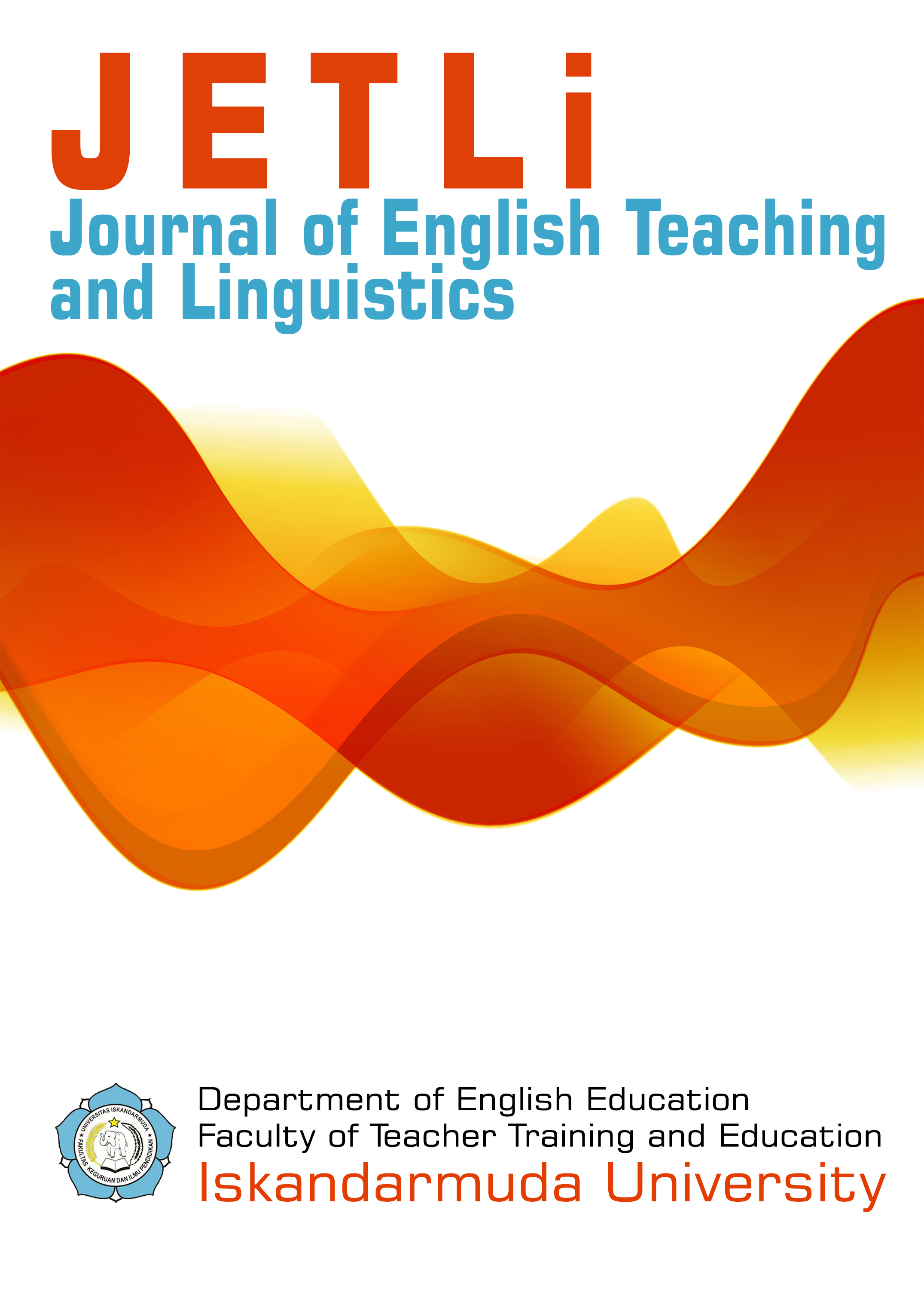THE EFFECTIVENESS OF SQ4R COOPERATIVE LEARNING METHOD ON READING LEARNING FOR EFL STUDENTS
DOI:
https://doi.org/10.55616/jetli.v1i2.24Keywords:
Cooperative Learning, Reading Learning, SQ4R, EFL StudentsAbstract
The aims of study is to determine the effectiveness of the SQ4R method in learning to read comprehension at SMAN 1 Darul Imarah. This study used a pre experimental design with a One Group Pretest Posttest Design design. The subjects of this study were students of class X (IPS 1) at SMAN 1 Darul Imarah. Data were analyzed using Effect Size. The results showed that the pretest mean score before using the SQ4R method was 62.59 and the posttest mean score was 82.76. Based on the calculation of Effect Size, where the Effect Size value between the pretest and posttest is 1.28 with a large category, meaning that there is the effectiveness of the application of the SQ4R method on student learning outcomes in learning reading comprehension in class X (IPS 1) SMA Negeri 1 Darul Imarah
References
Anderson, N. J. (1999). Exploring second language reading: Issues and Strategies. Boston, MA: Heinle & Heinle.
Alderson, J.C. (2000) Assessing Reading Cambridge. C.U.P.
Applegate, M., Quin, K., & Applegate, A.J. (1994). Using Metacognitive Strategies to Enhance Achievement for at-risk Liberal Arts College Students, Journal of Reading, 38(1), pp. 32-42.
Basar, M., & Gurbuz, M. (2017). Effect of the SQ4R Technique on the Reading Comprehension of Elementary School 4th Grade Elementary School Students. International Journal of Instruction, 10(2), pp. 131–144. http://www.e-iji.net/dosyalar/iji_2017_2_9.pdf
Becker, H. J. (2000). Findings from The Teaching, Learning, and Computing Survey. Education Policy Analysis Archives, 8 (51), pp. 1-31. https://doi.org/10.14507/epaa.v8n51.2000
Bonner, S. E. (1999). Choosing Teaching Methods Based on Learning Objectives: An Integrative Framework. Issues in Accounting Education, 14(1), pp. 11-15. https://doi.org/10.2308/iace.1999.14.1.11
Brassell, D., & Timothy, R. (2008). Comprehension that Works Taking Students Beyond Ordinary Understanding to Deep Comprehension. Shell Education.
Coon, D., & Mitterer, J. O. (2013). Psychology: A Journey. Cengage Learning.
Epçaçan, C. (2009). Okudu?unu Anlama Stratejilerine Genel Bir Bak??. Uluslararas? Sosyal Ara?t?rmalar Dergisi, 2(6), pp. 207-223. https://www.sosyalarastirmalar.com/cilt2/sayi6pdf/epcacan_cevdet.pdf
Grabe, W., & Stoller, F. L. (2001). Action Research as Reflective Teacher Practice in The Context of L2 Reading Classrooms. Journal for Language Teaching= Ijenali Yekufundzisa Lulwimi= Tydskrif vir Taalonderrig, 35(2-3), pp. 97-109. https://journals.co.za/content/journal/langt
Hennings, D. C. (1997). Communication in Action: Teaching Literature-Based Language Arts (Sixth Edit). Houghton Mifflin Company.
Li Bin. (2010). Bahasa Inggris Mudah Dipelajari tetapi Sulit Dikuasai. Overseas English, (1X), pp. 24-25.
Peregoy, S. F., & Boyle, O. F. (2017). Reading, Writing, and Learning in ESL: A Resource Book for Teaching K-12 English Learners (Seventh Ed). Pearson Education, Inc.
Sariakin, S., & Rizka, B. (2020). A Study on The Teaching and Learning Process of Reading Skill at Mathayum Islam Bachok Wittaya School Thailand. JETLi: Journal of English Teaching and Linguistics, 1(1), pp. 55-62. https://ejournal.unida-aceh.ac.id/index.php/jetli/article/view/11
Shea, M., & Roberts, N. (2016). The Fives Strategy for Reading Comprehension. Learning Sciences International.
Snow, C. (2002). Reading for Understanding: toward an R&D Program in Reading Comprehension. RAND.
Spivey, N. N. (1991). The Shaping of Meaning: Options in Writing the Comparison. Research in the Teaching of English, 25(4), pp. 390-418. https://www.jstor.org/stable/40171203
Spear, S. L. (2015). The Power of RTI and Reading Profiles. A Blueprint for Solving Reading Problems. Paul H. Brooks Publishing Co., Inc.
Zhang, L. (2018). Metacognitive and Cognitive Strategy Use in Reading Comprehension. Springer Nature Singapore Pte Ltd.

Published
How to Cite
Issue
Section

This work is licensed under a Creative Commons Attribution 4.0 International License.
Authors retain copyright and grant the journal right of first publication with the work simultaneously licensed under an Attribution 4.0 International (CC BY 4.0) that allows others to share — copy and redistribute the material in any medium or format and adapt — remix, transform, and build upon the material for any purpose, even commercially with an acknowledgment of the work's authorship and initial publication in this journal.






 Journal of English Teaching and Linguistics
Journal of English Teaching and Linguistics